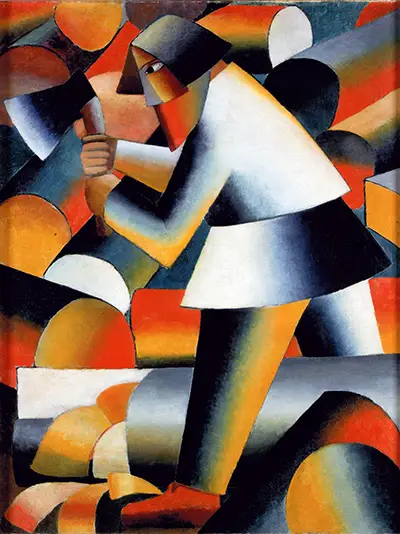This oil on canvas painting, entitled Woodcutter, was created in 1912 by the Russian artist Kasimir Malevich. It is a brightly coloured neo-primitive work in the Cubism style.
The whole frame is filled with the abstract form of a woodcutter working amongst a pile of logs with a short-handled axe. This avant-garde style of modern art, which became popular in the early 20th Century reduces natural forms to their geometric equivalents.
The complex outlines of natural objects and subjects are presented as solid geometric shapes, cylinders, spheres, rectangles, and cubes. The colouring and shading give the image a flat and mechanical appearance.
In 1907, when Malevich moved from Ukraine to Moscow he was introduced to the work of the avant-garde painters, Natalia Goncharova and Mikhail Larionov. He became attracted to Russian folk art and combined that with symbolism, impressionism, fauvism, and cubism. Woodcutter is one example of his portrayal of large, swarthy peasants at work. The painting, which measures 94cm x 71.5cm, can be viewed at Stedelijk Museum, Amsterdam.
Kasimir Malevich was born in 1879 in Ukraine, to Polish parents who travelled throughout Russia in search of work. His father was employed, for a time, in railway construction and the young Kasimir joined him in his early teenage years. At the age of twelve, Malevich started to draw and set his mind on a career in art. He attended several art schools, beginning with the Kiev School of Art in 1895. Then in 1904, Malevich moved on to the Stroganov School of Art in Moscow. He then continued at the Moscow School of Painting, Sculpture, and Architecture, where his early work was influenced by the Impressionist and Post-Impressionist teaching he received there.
In 1907, Malevich made the acquaintance of Wassily Kandinsky, Mikhail Larionov, and David Burliuk. Their influence prompted a move towards a more unconventional style to his work. A lot of Malevich’s work following this period involved rustic scenes of peasant life. Then in 1912, he worked in a Cubo-Futuristic style resulting in the geometric portrayal of natural forms, one example of which is Woodcutter.
In 1915, Malevich published a manifesto entitled, From Cubism to Suprematism, following which he gave up the figurative elements in his painting in favour of pure abstraction. He then worked alongside other Suprematist artists in Skoptsi and Verbovka village. Then in 1916-1917, he took part in exhibitions of the Jack of Diamonds group along with colleagues, including, David Burliuk, A. Ekster, and Nathan Altman. Examples of Malevich’s Suprematist paintings include Black Square and White on White. Malevich was fascinated with aerial photography. This additional element opened up new possibilities and his Suprematist work produced a series of familiar aerial landscape views rendered into abstraction.
After the October Revolution, Malevich joined the Collegium on the Arts of Narkompros, commissioned for the protection of museums and monuments. He taught at the Vitebsk Practical Arts School in the USSR 1919-1922, The Leningrad Academy of Arts 1922-1927, the State Art Institute in Kiev 1927-1929, and the House of Arts in Leningrad in 1930. Malevich published his book, The World as Non-Objectivity in 1926 which outlines his Suprematist theories.
Malevich’s work has not been universally accepted without criticism. The Western artist/art historian Alexandre Benois criticised his style as being devoid of goodness and purity and lacking in love of nature or life. Malevich’s response was that art could develop and advance for art’s sake alone: art has no need of us, never has and never will.
In 1927, Malevich travelled to Warsaw then onto Berlin and Munchen where he finally gained international recognition. He made arrangements to leave most of his paintings in Germany when he returned to the USSR, correctly anticipating the shift in policy by the Soviet Authorities towards modern art after the fall of Lenin and Trotsky. The Stalin regime condemned all types of abstract art as the work of the ‘bourgeois’ and Malevich was banned from producing or exhibiting such work.
Much more recently, with changes in the rigid politics and regime within the Soviet bloc, Malevich’s work has reappeared in art exhibitions in Russia. A book of his, including, art theory and reminiscences has been published since he died of cancer in 1935. Malevich was exhibited on his death bed with the Black Square above him. His tomb is marked by a white cube decorated with a black square.




